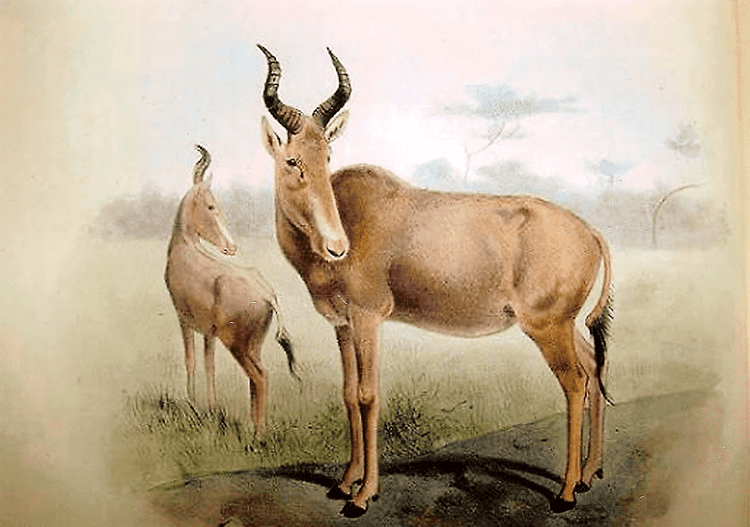Order Artiodactyla Subfamily Alcelaphinae Higher classification Hartebeest | Phylum Chordata Genus Alcelaphus Rank Subspecies | |
 | ||
Scientific name Alcelaphus buselaphus buselaphus Similar Hartebeest, Alcelaphus, Mammal, Syrian wild ass, Lelwel hartebeest | ||
The bubal hartebeest, also known as bubal antelope or simply bubal (Alcelaphus buselaphus buselaphus) is the extinct nominal (i.e., first described) subspecies of hartebeest, that was formerly found north of the Saharan Desert. Other subspecies live currently in grasslands south of the Sahara, from Senegal in the west to Eritrea and Ethiopia in the east and down to middle Tanzania. The red hartebeest and Lichtenstein's hartebeest, alternatively considered subspecies or sister species of the common hartebeest, are present in southern Africa.
Contents
- Description
- History and extinction
- Zoo and museum specimens
- Relation with ancient civilizations
- References

Description

The bubal hartebeest was described as uniformly sandy colored, save for "an ill-defined patch of greyish on each side of the muzzle above the nostrils" and the terminal tuft of the tail, which was black. In this case the subspecies was similar to the plain colored Lelwel hartebeest, lacking white or black facial markings such as those present in the western hartebeest and Swayne's hartebeest. It measured 43 inches at the shoulder and the horns were 'U' shaped when seen from the front.

Like other hartebeests, the bubal was a social animal. Luis del Mármol Carvajal wrote that herds of 100 to 200 animals could be seen in northern Morocco in 1573. According to 19th century writers, the bubal hartebeest preferred rocky areas with a fair amount of vegetation, in contrast to the sandy and drier habitat of the Addax. Its main predator was the also extinct Barbary lion.
History and extinction

The bubal hartebeest ranged originally across Africa north of the Sahara, from Morocco to Egypt, where it disappeared earlier. It was also present with certainty in the Southern Levant prior to the Iron Age, while Harper (1945) mentions "none too well substantiated" recent historical records from Israel and even Arabia. The northern limit of the bubal hartebeest's range was the Mediterranean coast; large herds were still reported existing in Morocco north of the Atlas Mountains in 1738. As for the southern limits of its distribution, "wild oxen (Antilope bubalis)" are mentioned living in the Tassili mountains of the central Sahara in 1850. However, the identity of these last animals is debatable. Even if they were indeed hartebeest, they might not belong to the northern subspecies.
The subspecies declined sharply during the course of the 19th century, especially after the French conquest of Algeria, when entire herds were massacred at once by the colonial military. By 1867 it could only be found in the mountain ranges of north-western Africa that are near or within the Saharian desert. It disappeared from the Tunisian Atlas in 1870, and the last animal in this country was shot in 1902 near Tataouine. Outside of this instance, the bubal seems to have entered the 20th century restricted to the Western Atlas, from Boulemane in Morocco to the south of the Wahran department in Algeria. The last known herd, numbering only 15 animals, was located near Outat El Haj, Morocco in 1917; all but 3 of them were killed by the same hunter. The last animal in Morocco was shot in Missour in 1925. It probably disappeared around the same time in Algeria. One last specimen is mentioned as having been 'collected' in the 1920s near Geryville, south of the Chott Ech Chergui. While Harper, writing in 1945, considered that the subspecies could still possibly exist at the time in this area, he also mentioned that different campaigns in the 1920s and 1930s failed to find any animals in Morocco, Algeria or Tunisia, even in regions where it had been reported as numerous only a few decades before. In addition, it was said by scientists that there may be a few left after being reported that someone in Morocco in 2013 thought to see this Hartebeest eating off a tree.
The bubal hartebeest was protected under the London Convention of 1933.
Zoo and museum specimens
Individuals of bubal hartebeest were sometimes captured and kept in British, French and German zoos around the start of the 20th century, although Ruxton and Schwarz (1929) failed to find any preserved in museums of these countries. The last captive bubal, a female (sometimes wrongly reported as the last bubal ever), died in Paris in 1923. The Academy of Natural Sciences of Philadelphia received another female in 1905 from the Zoological Society of Philadelphia, which was stuffed. This is possibly the only bubal preserved in the United States of America.
Relation with ancient civilizations
Remains of bubal hartebeests have been found in several Egyptian archaeological sites such as Abadiyeh, Saqqara and Karanis, the last one dating to the early Middle Ages. A hieroglyph meaning "baby hartebeest" also existed:
For these reasons, it has been suggested that the bubal was domesticated in Ancient Egypt, or at least used as a sacrificial animal. It is also mentioned in the Old Testament under the name of Yachmur (1 Kings 4:23).
The bubal hartebeest is one of many extinct animals depicted in the Roman mosaics of Hippo Regius (modern Algeria) that date back to the 2nd and 4th centuries AD.
